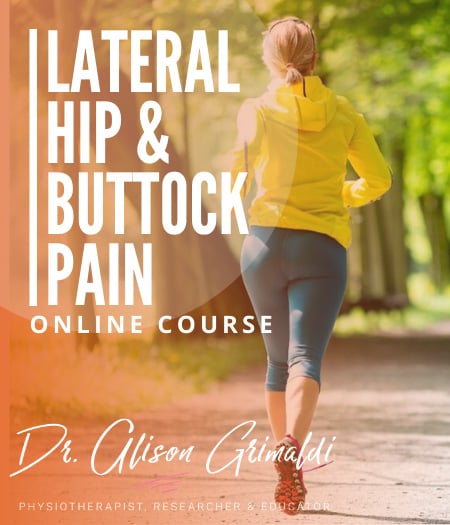3 Yoga Poses to Modify for Hip Pain

In last month’s blog, I discussed 3 of my least favourite Pilates exercises for patients with hip pain. This month I’ll be focusing on 3 yoga poses to modify for hip pain. These are not exercises I dislike, in fact there is a lot of value in these 3 weightbearing exercises. However, the execution of these poses can make all the difference between a helpful activity and a provocative activity for those with certain painful hip pathologies. Today we’ll look at who might be provoked by these yoga poses and why, as well as how we can modify these 3 yoga poses for patients with hip pain.
Discover our Lateral Hip & Buttock Pain Course
If you enjoyed this blog, you might like to take the online course on Anterior Hip & Groin Pain - 6 hours of guided online video content. Examine various joint-related, soft tissue-related and nerve-related conditions associated with lateral hip and buttock pain, their mechanisms, associated impairments, clinical diagnostic tests and management approaches. To learn more, take the lateral hip and buttock pain online course, or join me in an online or practical lateral hip and buttock pain workshop.
This blog contains a free downloadable resource. Read to the bottom to claim your gift.
Yoga is an ancient form of exercise, originating in India thousands of years ago. The practice of yoga spread to Western civilisation in the late 1800’s and its popularity has continued to grow ever since.1 Many benefits of yoga have been cited, including increased strength and flexibility, improved sleep, reduced stress and increased relaxation.2 Yoga has also been reported to assist in managing pain in musculoskeletal conditions, even in older individuals.3
However, although yoga is a non-contact, low-impact physical activity, it is certainly not benign. Musculoskeletal injuries occur regularly, and this is likely related to the yoga asana or postures exposing muscles, joints and bones (particularly spinal vertebrae in those with low bone mineral density) to the edges of their physiological competence.
Yoga injury rates and influencing factors
A survey study of 2260 yoga practitioners predominantly from North America and Europe reported the following key findings:2
- 55% of yoga practitioners reported they had suffered a yoga related injury
- The majority of injuries were reported as sprains or strains (47.1%)
- 28% of injuries were rated as mild, 63% as moderate and 9% as severe
- Injuries most commonly occurred in the knees, lower back, shoulders and hips/hamstrings
- Participants were most likely to attribute their injury to pushing themselves too far or being pushed too far by a teacher's adjustments
- Injuries were much more likely to occur (86%) when participants were doing the full expression of a pose (pushing to the limits), rather than a modified version
- Injuries were more likely to occur within a group, guided class, rather than during self-practice.
These last 3 points all have a common theme – yoga injuries are more likely to occur when people push to their limits and not surprisingly, this is more likely to occur within a group class. Others refer to ‘ego-driven’ injuries, where students injure themselves when they are tempted or encouraged to keep up with others in a group environment.4
I recall one of my own patients mentioning that the best yoga class she ever did was a class where the teacher instructed everyone to keep their eyes closed. She said this took all the competition and pressure away, and she could just relax and do what she felt was comfortable for her own body. Not that I’m suggesting that people should always practice yoga with their eyes closed! But avoiding any natural competitive tendencies and working within an individual’s own limits is critical for the best risk-benefit balance in yoga practice.
For those with hip pain, there are a number of yoga poses that are quite challenging and can be provocative. One study on yoga practitioners with femoroacetabular syndrome, reported that 71% had to stop practicing yoga because of hip related symptoms, but 93% managed to return to yoga at around 5 months post hip arthroscopy.5
In this blog, we’ll be looking at 3 yoga poses to modify for hip pain, and how health and exercise professionals can provide specific load management advice for these poses, to reduce loads at the hip through simple alterations in position.
No. 1 Yoga Pose to Modify for Hip Pain: Warrior Pose
The warrior pose has 3 main variations. Warrior I, with arms extended overhead with trunk extension as pictured below and Warrior II, with arms held in 90 degrees abduction, are the 2 versions that may not be well tolerated by some people with hip pain.
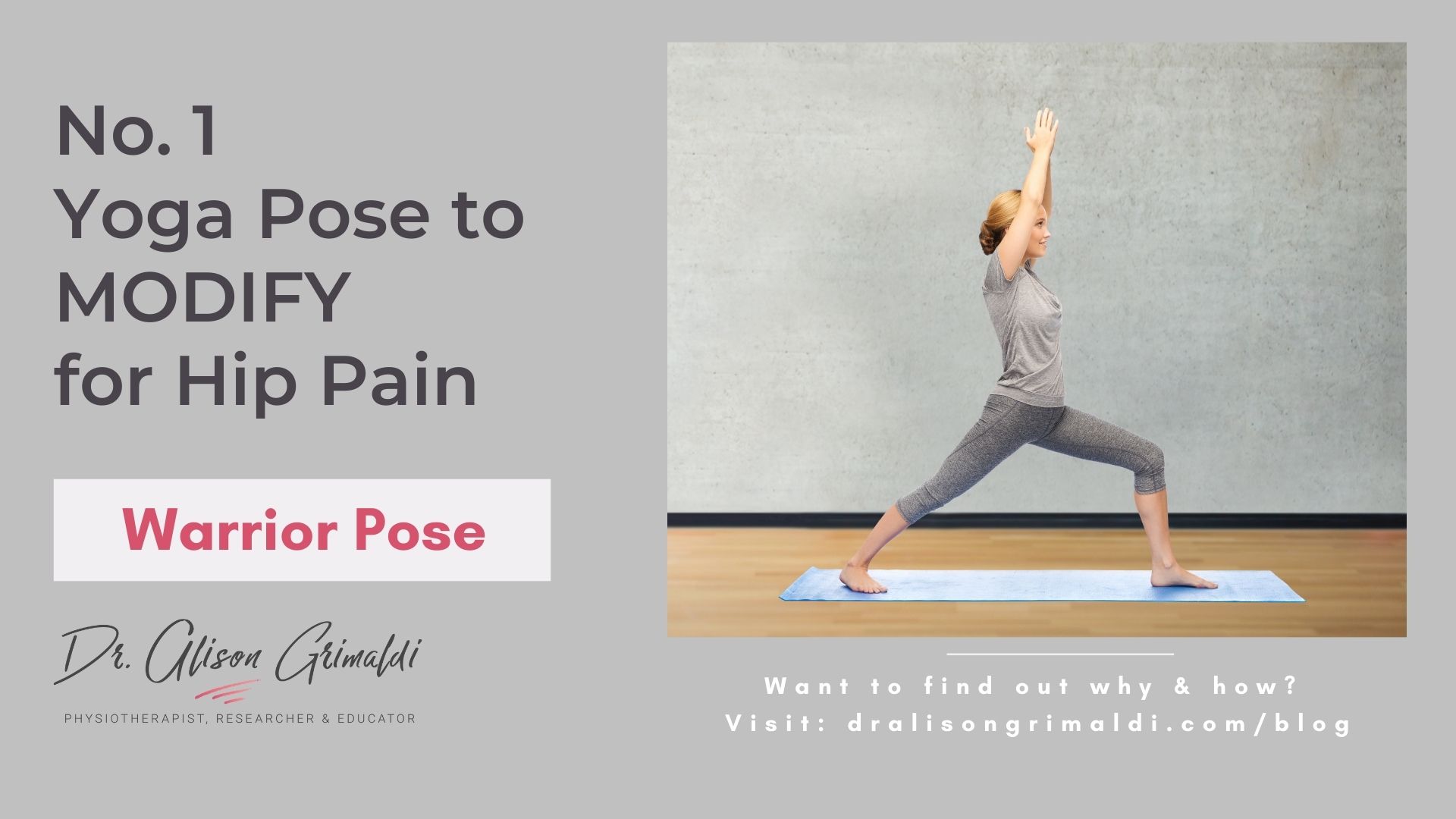
Exacerbation of anterior hip pain in Warrior Pose
End range extension of the back hip in this pose places large loads on the anterior joint structures and hip flexors. The combination of extension and external rotation of the back hip places even greater loads on the anterior capsuloligamentous structures. Particularly if the individual has inadequate local stability mechanisms, excessive anterior shear of the femoral head within the acetabulum may occur. This increases pressure on the anterosuperior chondral surfaces, the labrum and chondrolabral junction and the capsule.
With the iliopsoas at its maximal length and actively contracted, the psoas tendon may strongly impinge against the adjacent anterior labrum and the femoral head. If there is already painful pathology of the labrum, such forces particularly when sustained, are likely to provoke hip pain. If the patient has painful iliopsoas tendon pathology, the sustained compression as it wraps around the femoral like a fulcrum, can also be provocative.
Those most likely to be at highest risk of injury or pain exacerbation from sustaining such a position are individuals with excessive femoral anteversion and/or reduced anterior stability – acetabular dysplasia, hypermobility spectrum disorders or hypermobile EDS, labral insufficiency or focal capsuloligamentous incompetence related to an injury, overstretching or surgery (hip arthroscopy or anterior approach total hip replacement).
Learn more about anterior hip instability here
Exacerbation of posterior hip pain in Warrior Pose
This position of end-range hip extension and external rotation not only places the anterior hip in an extreme ‘open’ position but places the posterior hip in an extreme ‘closed’ position, increasing risks of posterior impingement. This can be either posterior femoracetabular impingement (FAI) or extra-articular impingement of the quadratus femoris between the ischium and lesser trochanter - ischiofemoral impingement.
Learn more about posterior hip impingement here
Modifying Warrior Pose to avoid exacerbation of hip pain
Weightbearing squats and lunges can be very beneficial for conditioning of the lower limb musculature, so rather than avoiding this pose, simple cues can substantially reduce the load on the hip structures while maintaining the physical and mental benefits of the pose.
- Reduce depth of the lunge
- Turn the toes of the back foot towards the front to reduce hip external rotation
- Lift the back heel and bend the back knee a little to reduce hip extension
- Reduce time spent in the position – move in and out of the position holding for shorter times.
The health professional should ask the patient to perform the pose under their supervision, take careful note of hip and pelvic position and modify form to minimise any provocative loads on the hip.
Warrior Pose may aggravate anterior hip joint and soft tissue conditions and posterior impingement, but simple modifications can help
No. 2 Yoga Pose to Modify for Hip Pain: Tree Pose
The Tree Pose is once again a useful weightbearing stimulus for hip musculature, but how the technique is performed may shift the risk-reward scales more towards risk than reward. The Tree Pose involves sustaining a single leg stance position with the other foot resting above the medial thigh and the non-weightbearing hip held in end-range horizontal abduction-external rotation (see picture below).
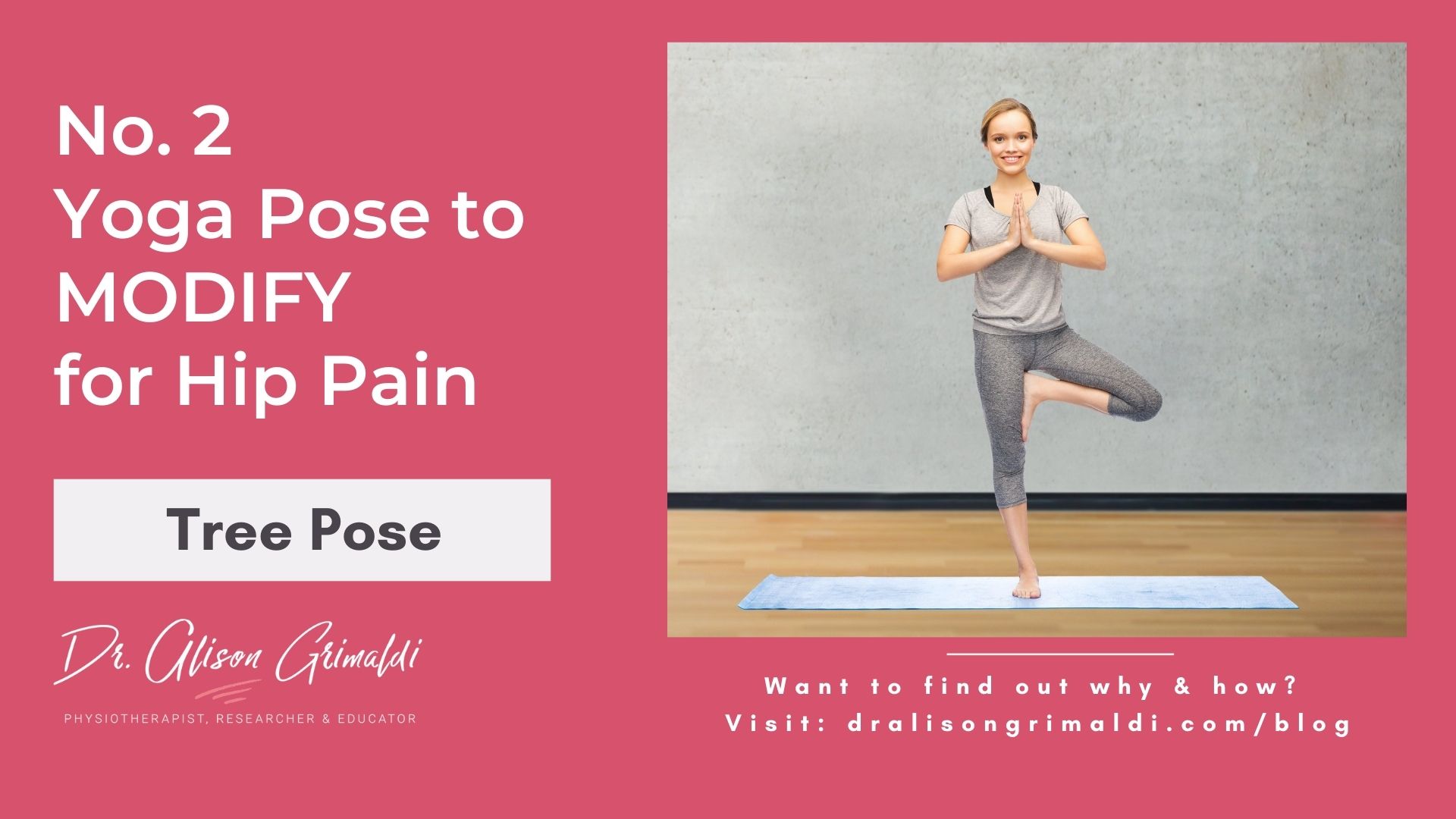
Exacerbation of hip pain on the weightbearing side in Tree Pose
On the weightbearing side, the position of the pelvis on the femur will have a critical influence on joint and tendon loads. For example, if the pelvis translates forward excessively relative to the base of support at the foot and/or posteriorly tilts excessively, the hip will once again be in a position of sustained extension, potentially giving rise to similar anterior joint related pain as discussed above.
In the coronal or frontal plane, if the pelvis shifts laterally excessively and/or sinks into excessive lateral pelvic tilt (contralateral drop), patients with gluteal tendinopathy may find their lateral hip pain is exacerbated due to the higher compressive loads at the greater trochanter. Those with lateral rim pathology of the hip joint might also find their ‘c-sign’ joint-related pain is exacerbated, particularly those with acetabular dysplasia where this position is likely to significantly increase labral loading.
Exacerbation of hip pain on the non-weightbearing side in Tree Pose
Although the non-weightbearing side is not absorbing bodyweight, the enthusiasm with which the knee is pushed back, opening the hip, may influence hip loads on that side. In forced hip abduction and external rotation, the anterior joint structures will again be loaded, although not to the same extreme as the Warrior Pose usually. However, for someone with excessive femoral anteversion, forcing their painful hip into this position may be very provocative.
Impingement may also occur posteriorly but in this flexion-abduction-external rotation position the most likely impingement is an extra-articular impingement of the greater trochanter against the ischium, which may also impinge the sciatic nerve.
Learn more about gluteal tendinopathy and greater trochanter-ischial impingement here
Modifying Tree Pose to Avoid Exacerbation of Hip Pain
Single leg hip-hitch type exercises have been shown to be a great stimulus for the gluteus medius muscle and by achieving a slight hip hitch, greater lateral coverage of the femoral head will occur, reducing rim loading laterally. Cues to reduce excessive pelvic translation and tilting can reduce provocation and increase reward from this exercise.
- Bring the pelvis back over the ankle (avoid excessive anterior shift/hip extension)
- Think tall and keep the weightbearing hip ‘in’ from the side – this should induce a gentle hip hitch
- Don’t push the non-weightbearing side knee back to it’s extreme – allow the knee to point further forward to a comfortable position.
For those who don’t have adequate capacity to control their pelvic position:
- Use some upper limb support on the non-weightbearing side
- Rest the ball of the other foot to the ground or on a block, to allow some partial load sharing through the other side until strength and tolerance is adequate.
- Reduce time spent in the position – move in and out of the position holding for shorter times.
No. 3 Yoga Pose to Modify for Hip Pain: Twisted Lunge Pose
The Twisted Lunge Pose or Revolved Lunge Post involves sustaining a lunge position but with the trunk inclined forward bringing the front hip into often full flexion (see picture below). Then the trunk is rotated towards the front thigh and the pelvis follows, increasing relative hip internal rotation and often adduction.
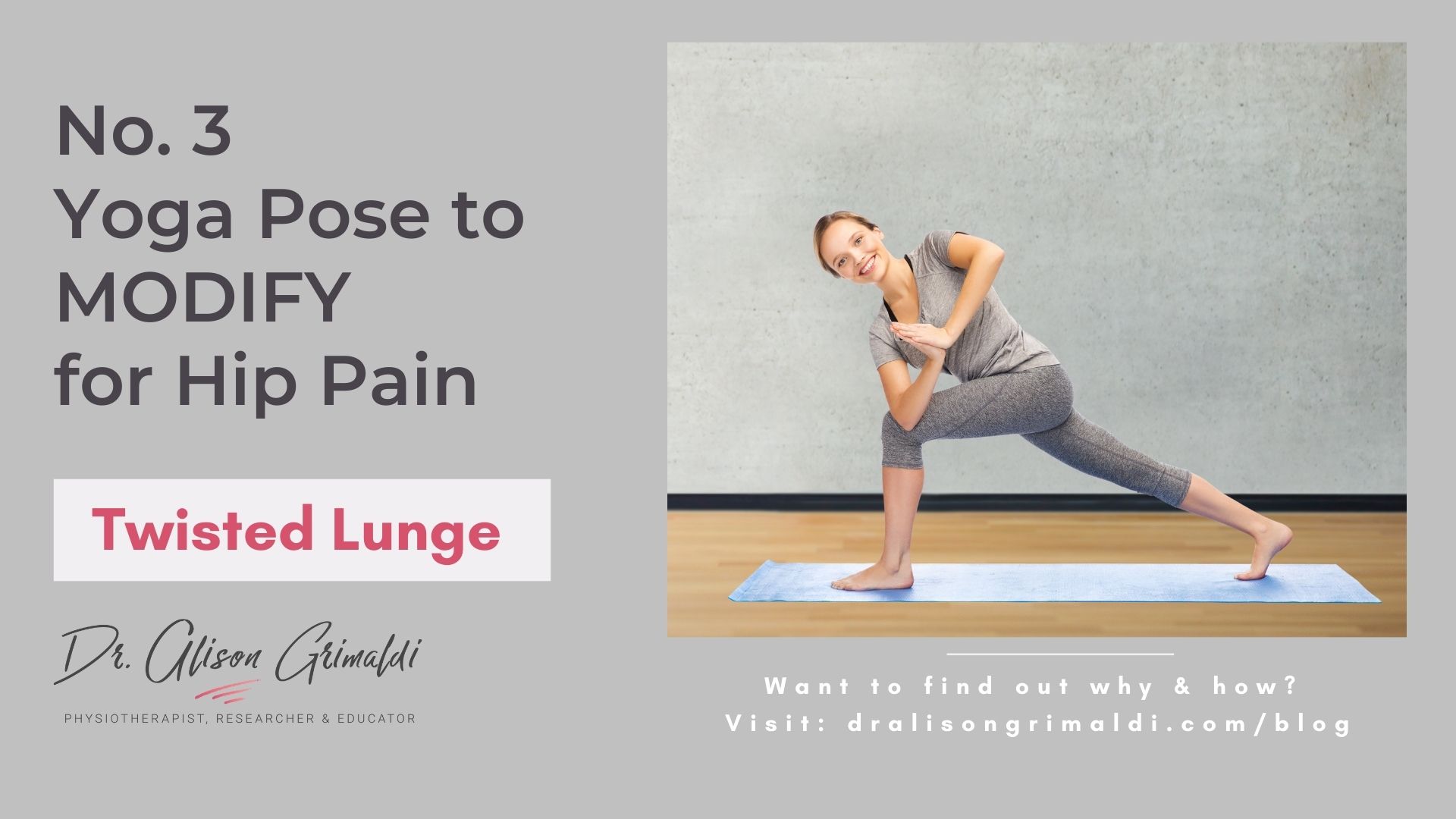
Exacerbation of anterior hip pain in the Twisted Lunge Pose
This position– flexion/adduction/internal rotation - you will recognise as a position of anterior femoroacetabular impingement. For patients with anterior chondrolabral pathology and particularly for those with cam morphology and femoroacetabular impingement syndrome, sustaining such a position, or repetitively rotating the pelvis in that deeply flexed position may provoke symptoms.
Learn more about femoroacetabular impingement syndrome here
Exacerbation of posterior hip pain in the Twisted Lunge Pose
As we discussed in the warrior pose, when one side of the joint is placed in an extreme of opening or closing, the opposite side of the joint is exposed to the opposite extreme. So, if the anterior joint is in an extreme ‘closed’ position – a position of impingement – the posterior aspect of the joint will be in an extreme ‘open’ position.
For most people this is not much of an issue, as the deep posterior acetabulum provides excellent posterior stability for the joint. However, for those with femoral retroversion, reduced bony coverage posteriorly (acetabular dysplasia/acetabular retroversion) and/or a lack of adequate posterior capsuloligamentous integrity (hypermobility or iatrogenic after posterior approach total hip replacement), this position may place the posterior joint at risk.
Learn more about posterior hip instability here
Modifying Twisted Lunge Pose to Avoid Exacerbation of Hip Pain
The most potent factor here for exacerbation of hip pain, is also the most easily modified - the degree of hip flexion. If the patient is willing and teacher accommodating, changes can be quickly made to this exercise to avoid exacerbation of hip pain in the twisted lunge pose.
- A block can be used in the hand opposite the front leg, to support the trunk weight, reduce hip flexion and there will also usually be less hip adduction and internal rotation
- Keeping the trunk upright and performing trunk rotation in this position can still provide a good opportunity for thoracic mobilisation but without the hip impingement.
I hope you found this information helpful. If you would like some further graphics demonstrating ways to modify these poses, and a summary of the key information from this blog, I have prepared a downloadable full colour resource for those of you who are keen to join our mailing list for monthly updates.
Hip Academy members - no need to sign up, this resource will be provided to you within your Hip Academy PDF Resource Library.
Another great Lateral Hip Pain blog
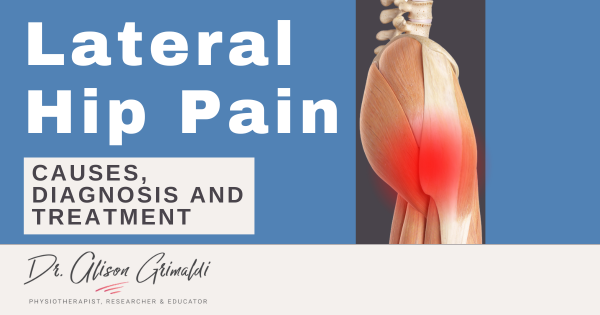
Lateral Hip Pain: Causes, Diagnosis, and Treatment
Sign up to our newsletter to receive updates on upcoming courses, news and special offers.
References
- Lee, M., Huntoon, E. and Sinaki, M., 2019. Soft Tissue and Bony Injuries Attributed to the Practice of Yoga: A Biomechanical Analysis and Implications for Management. Mayo Clinic Proceedings, 94(3), pp.424-431.
- Wiese, C., Keil, D., Rasmussen, A. and Olesen, R., 2019. Injury in yoga asana practice: Assessment of the risks. Journal of Bodywork and Movement Therapies, 23(3), pp.479-488.
- Denham‐Jones, L., Gaskell, L., Spence, N. and Tim Pigott, 2021. A systematic review of the effectiveness of yoga on pain, physical function, and quality of life in older adults with chronic musculoskeletal conditions. Musculoskeletal Care, Jun 14. doi: 10.1002/msc.1576. Online ahead of print.
- Campo, M., Shiyko, M., Kean, M., Roberts, L. and Pappas, E., 2018. Musculoskeletal pain associated with recreational yoga participation: A prospective cohort study with 1-year follow-up. Journal of Bodywork and Movement Therapies, 22(2), pp.418-423.
- Frank, R., Ukwuani, G., Allison, B., Clapp, I. and Nho, S., 2018. High Rate of Return to Yoga for Athletes After Hip Arthroscopy for Femoroacetabular Impingement Syndrome. Sports Health: A Multidisciplinary Approach, 10(5), pp.434-440.

